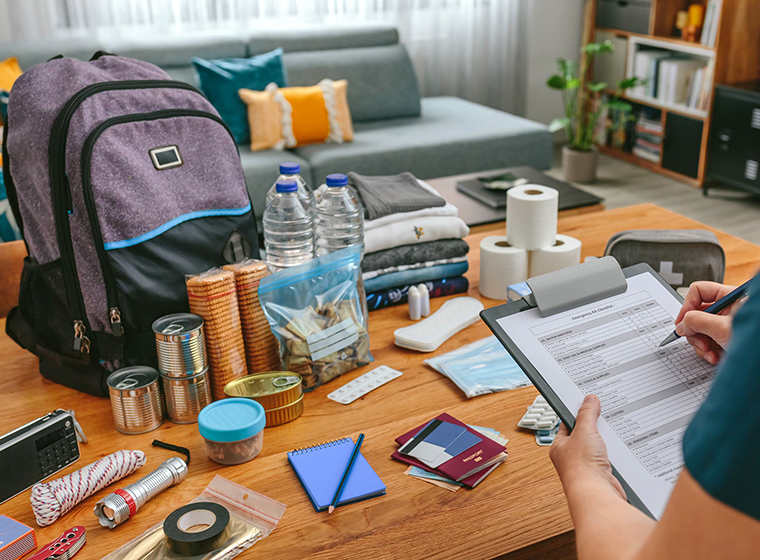Emergency Preparedness
Emergency Preparedness week is held annually in May and is a great opportunity to update your emergency plan and kit.
Be Prepared for an Emergency
Before an emergency happens, it’s important to make sure you have a plan in place for your household. Follow the steps below to:
- develop your plan
- build an emergency kit
- make sure you stay informed should an emergency occur
Record the important details of your emergency plan using the format that works best for you, whether on paper or digitally. Make sure to include a copy of your plan in your emergency kit and share it with those in your household.

Power Outages
During a power outage, you may be left without heating/air conditioning, lighting, hot water, or even running water. If you only have a cordless phone, you will also be left without phone service. If you do not have a battery-powered or crank radio, you may have no way of monitoring news broadcasts. In other words, you could be facing major challenges. Everyone has a responsibility to protect their homes and their families. You can greatly lessen the impact of a power outage by taking the time to prepare in advance.
This involves three basic steps:
1. Find out what to do before, during, and after a power outage.
2. Make a family emergency plan, so that everyone knows what to do, and where to go in case of an emergency.
3. Get an emergency kit, so that you and your family can be self-sufficient for at least 72 hours during a power outage.
Your Plan should include
Two safe locations in case you have to leave your home. One should be nearby - within the community. The other one should be farther away, outside the community.
A family communication plan: Local telephone lines and networks may not work. Identify one or two out of town contacts that can be used to connect and share information.
List of People: that can be able to help when you need it - family, neighbours, health-care/personal support workers.
- Before an Outage: Create a 72-hour emergency preparedness kits with the following supplies:
-Windup or battery powered flashlight and radio
-Portable external battery charger for smart devices
-Water (2 litres/person/day)
-Canned or dried food that won’t spoil and can opener
-Batteries
-Cash
-Blankets
-Candles and matches
-Emergency numbers and contacts
-First aid kit
-Medical or prescription items you require - During an Outage:
-To avoid damage when power is restored, unplug devices that may generate heat – except for refrigerators and freezers
-Do not open your freezer or refrigerator unless absolutely necessary
-Use proper candle holders. Never leave candles unattended
-If using generators, be sure to use in accordance with manufacturer’s guidelines and operate outdoors in a well-ventilated area - After an Outage:
-Gradually turn electrical appliances back on
-Wait until the temperature and humidity have returned to normal before turning electronic devices back on
-Check the food left in the refrigerator and freezer during your absence and throw out any that has spoiled
-Restock your emergency kit and provisions
Planning for a power outage will also help prepare you for other types of emergencies. You may wish to print off the guide and keep it in a handy spot, such as in your emergency kit.
For more information on power outages, what to do and how to be prepared, visit the following resources:
Hydro One - Be ready: Information about outages and steps to take before, during and after an outage
Government of Canada - Power Outages: What to do
Government of Ontario - Ontario Seniors: How to be Prepared
Flooding
Flood Risk Maps are avalable for viewing at the Civic Centre during regular business hours, and select maps are available electronically at the following links.
1. Monk Street to Minto Street (Map 5)
2. Teak Street to Elm Street (Map 6)
3. Highway 129 to Maple Street (Map 8)
4. Highway 129/101 Intersection to Miss Muggins (Map 13)
Additional Information
The Province maintains a Flood Forecasting and Warning Program, and copies of recent Flood Watch Bulletins issued by the MNRF are available online at this link.
Extreme Heat
Extreme heat can make you sick with:
- heat stroke
- heat rash
- heat cramps
Safety Tips
If you feel dizzy, weak or overheated:
- go to a cool place
- sit or lie down
- drink water
- wash your face with cool water
If you don't feel better soon, seek medical help immediately.
If you are indoors:
- stay indoors to limit sun exposure
- take frequent cool showers or baths
- stay on lower floors if there’s no air conditioning
- drink water and eat light, regular meals — avoid using salt
If you are outdoors:
- spend the hottest part of the day in air conditioned public buildings (e.g., mall, library, cooling station)
- drink water every 15 to 20 minutes even if you aren't thirsty
- dress in light-coloured, loose-fitting clothing covering as much of your skin as possible
- wear a wide-brimmed hat to protect your face
- wear full UVA and UVB protection sunglasses
- apply sunscreen with SPF 15 or higher 20 minutes before going outside
- apply lip balm with an SPF 15 or higher
Prepare now
Take the following steps so you and your family are prepared in the event of an emergency:
- cover windows that receive morning or afternoon sun with drapes, shades or awnings
- include extra water, sunscreen and sunglasses (with full UVA and UVB protection) in your emergency survival kit

